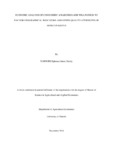| dc.description.abstract | Geographical indication (GI) identifies a product as originating from a given territory, region or country. This form of product-labelling signifies reputation for quality, safety and authenticity. It is a form of value-based label that can curb honey adulteration through enabling product traceability. This study analyzed honey consumers‟ awareness of GI and their willingness to pay for quality attributes of honey in Kenya. A quantitative experimental research design; choice experiment (CE) based on a D-optimal design was used. Primary data was collected through consumer surveys using structured questionnaires. Respondents were drawn from three urban centres: Nairobi, Nakuru and Kitui. In addition, consumers‟ awareness and preferences for geographical and quality honey attributes were analyzed using probit and random parameter logit models, respectively. Results reveal that consumers have limited knowledge of GI. Factors that influence GI awareness are consumers‟ perceptions, trust, gender, education level and information. Therefore, there is need to increase the spread of GI knowledge and its benefits through consumer education forums. Furthermore, consumers prefer local honey that is organic, with specific origin labels and produced in semi-arid areas. The study therefore recommends stringent labelling of honey with its specific region of origin and organic certification. Consequently, consumers are willing to pay a premium to improve the authenticity of current honey labels: origin and botanical labels for traceability and organic for food safety. Consumers also prefer a joint public-private regulation. There is a niche market for thick honey labelled with its GI, organic, botanical source and certified by both public and private body. This consumer segment would pay up to 430% premium. This study recommends for consumer education across gender and age and implementation of GI labelling for food products trusted by consumers. Stakeholders should be enabled to implement GI labels in Kenya because of high consumer preferences. | en_US |



